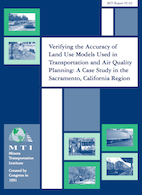- 408-924-7560
- mineta-institute@sjsu.edu
- Donate
Verifying the Accuracy of Land Use Models Used in Transportation and Air Quality Planning: A Case Study in the Sacramento, CA Region
Communities with air quality problems in California and across the nation are proposing major beltway and highway projects to address roadway congestion problems. However, the travel and emissions models used in conformity analyses and environmental impact statements have low accuracy. Travel demand models are typically estimated on and calibrated to observed data, but rarely validated against observed data not used in their estimation and calibration. Validation of a model is critical to determining the degree of precision to which it can be reasonably applied. In this historical forecasting case study in the Sacramento, California region, the original version of the Sacramento regional travel demand model (estimated with 1991 data) is used with Year 2000 observed data to validate the model over a nine-year period. Three simulations are performed to test, respectively, model accuracy, the effect of errors in socioeconomic/land use projections, and induced travel.
The results of the study suggest that the travel demand model (that is, its functional forms and parameters) overestimates vehicle miles traveled, vehicle hours traveled, and vehicle hours of delay (5.7, 4.2, and 17.1 percent, respectively). The errors in the socioeconomic/land use projections made in 1991 and used in the model approximately double the errors in vehicle travel. The model also underestimates induced travel (elasticity of 0.14) compared to the estimate of actual induced travel (elasticity of 0.22) in this study, but the upward bias in the model error swamps this underestimation. If the model were used for conformity analyses in this region, its overestimation of daily vehicle travel should provide a relatively generous margin of error with respect to meeting air quality emissions budgets. (Note that the version of the model used in this study is no longer used by the region.) On the other hand, in the analysis of travel effects of proposed highway investment projections in environmental impact statements, the overestimation of the daily travel results would tend to overestimate no-build travel demand and congestion and thus the need for new highway projects in the region. Compared to that in the no-build alternative, the magnitude of change for the highway alternative would have to be greater than the model error to be considered significantly different. This may be a difficult standard for the typical new highway project to meet.
CAROLINE RODIER
Caroline Rodier is a post-doctoral researcher at the University of California PATH and a Research Associate at the Mineta Transportation Institute. She has a PhD in Ecology, focusing on environmental policy analysis and transportation planning. Her research involves the use of integrated land use and transportation, regional travel demand, and emissions models to evaluate the travel, economic, equity, and air quality effects of a wide range of transportation (traditional and innovative) and land use policies. Her dissertation addresses key issues of uncertainty in travel and emissions modeling, in particular, population projections and induced travel.
Dr. Rodier has earned a variety of awards including the University of California Outstanding Transportation Student of the Year, the Federal Highway Administration's Dwight David Eisenhower Transportation Fellowship, and the Environmental Protection Agency's Science to Achieve Results Fellowship. She has authored more than 10 journal articles and 20 reports and proceedings articles.
-
Contact Us
San José State University One Washington Square, San Jose, CA 95192 Phone: 408-924-7560 Email: mineta-institute@sjsu.edu






